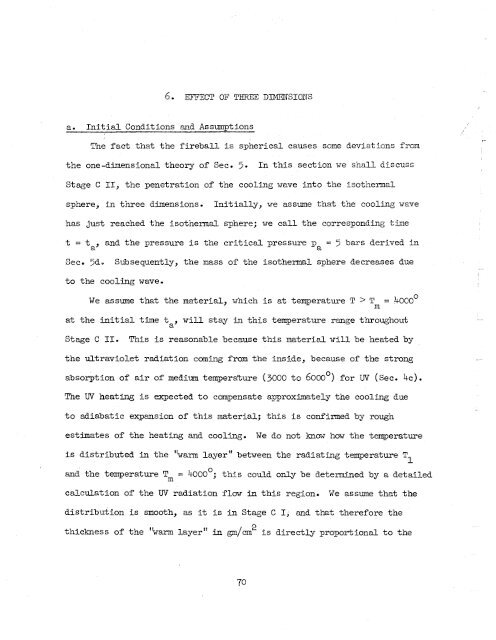Theory of the Fireball
Theory of the Fireball
Theory of the Fireball
You also want an ePaper? Increase the reach of your titles
YUMPU automatically turns print PDFs into web optimized ePapers that Google loves.
6. EFFECT OF THREE DDENSIOUS<br />
a. Initial Conditions and Assumptions<br />
The fact tnat <strong>the</strong> fireball is spherical causes some deviations from<br />
<strong>the</strong> one-dimensional tiieory <strong>of</strong> Sec. 5. In this section we shall discuss<br />
Stage C 11, tine penetration <strong>of</strong> <strong>the</strong> cooling wave into <strong>the</strong> iso<strong>the</strong>rmal<br />
sphere, in three dimensions. Initially, we assume tnat <strong>the</strong> cooling wme<br />
has just reached <strong>the</strong> isotnermal sphere; we call <strong>the</strong> corresponding tine<br />
t = ta, and <strong>the</strong> pressure is <strong>the</strong> criticd pressure p a = 5 bars derived in<br />
Sec. 5do Subsequently, <strong>the</strong> mass <strong>of</strong> tne iso<strong>the</strong>rmal sphere decreases due<br />
to tine cooling wave.<br />
We assume that <strong>the</strong> material, tfnich is at temperature T > Tm = !+OCOo<br />
at <strong>the</strong> initial time t will stay in this temperature range t'hroughout<br />
a'<br />
Stage C 11. Tnis is reasonable because this material will be heated by<br />
<strong>the</strong> ultraviolet radiation coming from <strong>the</strong> inside, because <strong>of</strong> tne strong<br />
absorption <strong>of</strong> air <strong>of</strong> medium temperature (3000 to 6000~) for W (Sec. 4c)<br />
The W heating is expected to compensate approximately <strong>the</strong> cooling due<br />
to adiabatic expansion <strong>of</strong> this material; tnis is confirmed by rough<br />
estimates <strong>of</strong> <strong>the</strong> heating and cooling. We do not know how tine temperature<br />
is distributed in <strong>the</strong> '%arm layer" between <strong>the</strong> radiating temperature T 1<br />
and Yne temperature Tm = 4000'; tnis could only be determined by a detailed<br />
calculation <strong>of</strong> <strong>the</strong> UV radiation flow in this region. We assume that <strong>the</strong><br />
distribution is smooth, as it is in Stage C 1, and that <strong>the</strong>refore <strong>the</strong><br />
2<br />
thickness <strong>of</strong> <strong>the</strong> 'harm layer" in gm/cm is directly proportional to <strong>the</strong><br />
..
















